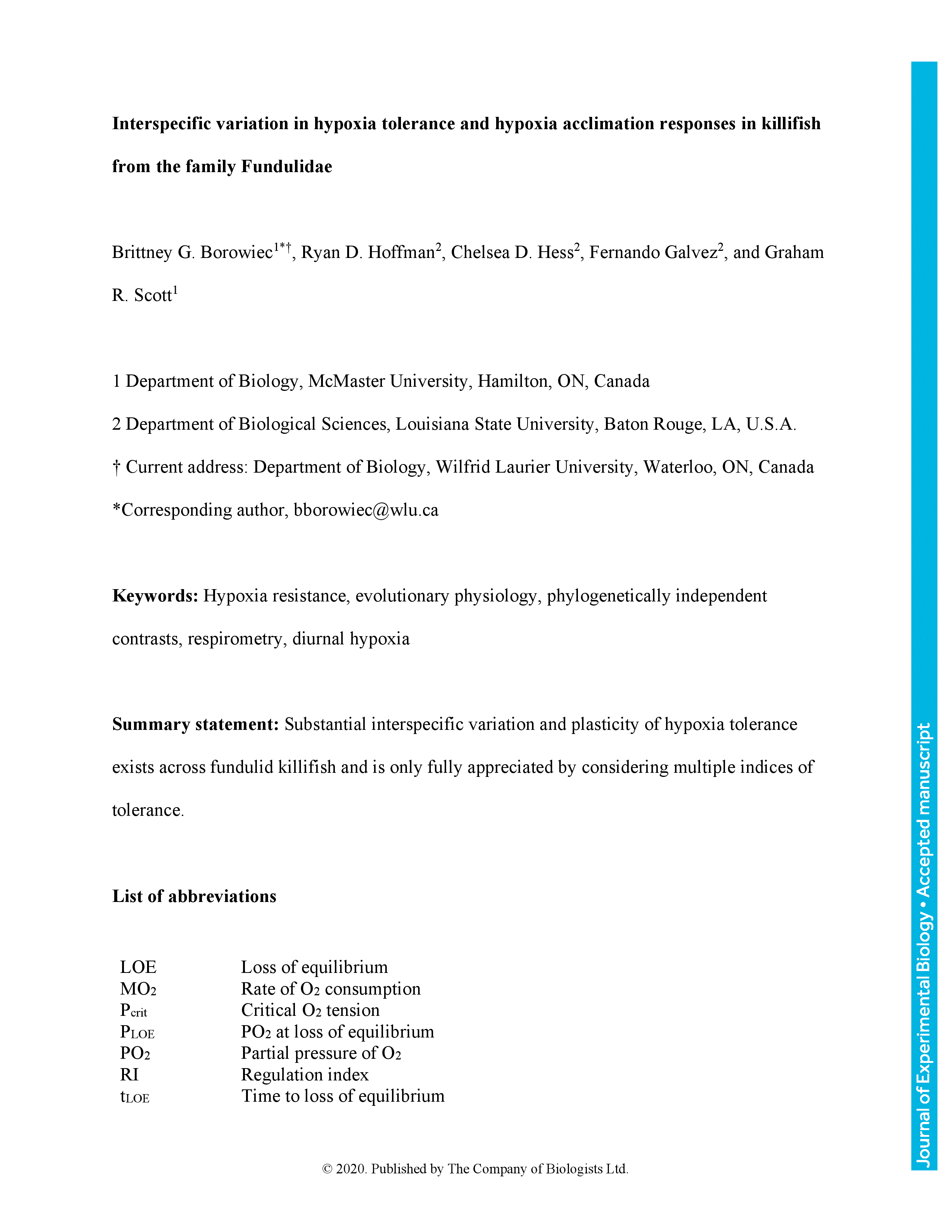Hypoxia is a pervasive stressor in aquatic environments, and both phenotypic plasticity and evolutionary adaptation could shape the ability to cope with hypoxia. We investigated evolved variation in hypoxia tolerance and the hypoxia acclimation response across fundulid killifishes that naturally experience different patterns of hypoxia exposure. We compared resting O2 consumption rate (MO2), and various indices of hypoxia tolerance (critical O2 tension [Pcrit], regulation index [RI], O2 tension [PO2] at loss of equilibrium [PLOE], and time to LOE [tLOE] at 0.6 kPa O2) in Fundulus confluentus, F. diaphanus, F. heteroclitus, F. rathbuni, Lucania goodei, and L. parva. We examined the effects of chronic (28 d) exposure to constant hypoxia (2 kPa) or nocturnal intermittent hypoxia (12 h normoxia: 12 h hypoxia) in a subset of species. Some species exhibited a two-breakpoint model in MO2 caused by early, modest declines in MO2 in moderate hypoxia. We found that hypoxia tolerance varied appreciably across species: F. confluentus was the most tolerant (lowest PLOE and Pcrit, longest tLOE), whereas F. rathbuni and F. diaphanus were the least tolerant. However, there was not a consistent pattern of interspecific variation for different indices of hypoxia tolerance, with or without taking phylogenetic relatedness into account, likely because these different indices are underlaid by partially distinct mechanisms. Hypoxia acclimation generally improved hypoxia tolerance, but the magnitude of plasticity and responsiveness to different hypoxia patterns varied interspecifically. Our results therefore suggest that hypoxia tolerance is a complex trait that is best appreciated by considering multiple indices of tolerance.
Interspecific variation in hypoxia tolerance and hypoxia acclimation responses in killifish from the family Fundulidae
Current address: Department of Biology, Wilfrid Laurier University, Waterloo, ON, Canada
Currently Viewing Accepted Manuscript - Newer Version Available
- Split-screen
- Views Icon Views
- Open the PDF for in another window
-
Article Versions Icon
Versions
- Version of Record 20 February 2020
- Accepted Manuscript 01 January 2020
- Share Icon Share
-
Tools Icon
Tools
- Search Site
Brittney G. Borowiec, Ryan D. Hoffman, Chelsea D. Hess, Fernando Galvez, Graham R. Scott; Interspecific variation in hypoxia tolerance and hypoxia acclimation responses in killifish from the family Fundulidae. J Exp Biol 2020; jeb.209692. doi: https://doi.org/10.1242/jeb.209692
Download citation file:
Advertisement
2023 JEB Outstanding Paper Prize shortlist and winner

The JEB Editors are delighted to announce the shortlisted authors for the 2023 JEB Outstanding Paper Prize. Read the winning paper - Tiny spies: mosquito antennae are sensitive sensors for eavesdropping on frog calls - by Hoover Pantoja-Sanchez and Brian Leavell from Ximena Bernal's lab at Purdue University, USA.
JEB Science Communication Workshop for ECRs

If you’re an early-career researcher interested in science communication and are attending the SEB Annual Conference in Prague this summer, come a day early and join the JEB Editors at a sci comm workshop to learn the key writing skills needed to promote your research to a broad audience beyond your peers (1 July at 14.30-17.30). Places are limited to 24 attendees, and applicants should apply through the SEB registration page by 30 April 2024.
Bridging the gap between controlled conditions and natural habitats in understanding behaviour

Novel technologies enable behavioural experiments with non-model species, in naturalistic habitats and with underexplored behaviours. In their Commentary, Scholz and colleagues discuss how to obtain a deeper understanding of the natural ecology and lifestyle of study animals.
Beluga metabolic measures could help save species

To help save animals from extinction, it’s important to understand what each species needs to survive. This led Jason John et al. to measure the metabolic rates of captive belugas to develop a ‘fish calculator’ showing that the whales need to eat ~23 salmon per day.
ECR Workshop on Positive Peer Review

Are you an ECR looking for tips on how to write concise, astute and useful manuscript reviews? If so, join the JEB Editors at a 2-hour JEB-sponsored Workshop on Positive Peer Review at the Canadian Society of Zoologists annual meeting in Moncton on 9 May 2024 at 13.00-15.00. There are 25 spaces for ECRs and selection is first come, first serve. To sign up, check the ECR Workshop box when you register for the CSZ meeting.



